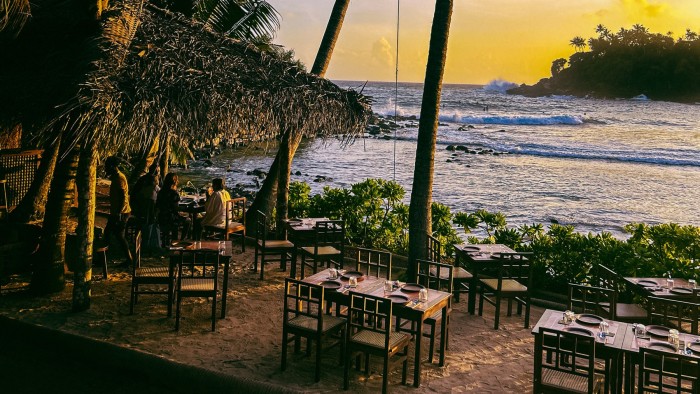Unlock the Editor’s Digest for free
Roula Khalaf, Editor of the FT, selects her favourite stories in this weekly newsletter.
It’s a sultry day in Sri Lanka, and I’m sitting at a waterside table at Raa, a new bar on the beach at Hiriketiya, a beautiful cove on the south coast. In my hand is an iced fuchsia cocktail of pink-skinned dragon fruit and “toddy”, a traditional hooch fermented from coconut flower sap that is gathered by toddy tappers who shin up the spindly coconut trees that tower overhead. On the table sit blue bowls of fragrant yellow dhal, scarlet prawns, snowy coconut rice and fiery sambals.
“We really want to bring back the local flavours,” says Raa managing partner Stephan Martinesz as he pours toddy from a terracotta pot. “There are only 200 toddy tappers left in the country so we try and keep that tradition alive.”


I’ve come here with Dom Fernando, the British-Sri Lankan owner of Paradise, in London, to learn more about the inspirations for his new drinks list, which celebrates Sri Lankan drinking. Created in partnership with British bartenders Max and Noel Venning, of the acclaimed Three Sheets cocktail bars in Soho and Dalston, it employs Sri Lankan ingredients from rambutan and curry leaves to jasmine, ginger and Ceylon Orange Pekoe tea. “I think Sri Lankan drinking culture is accelerating faster than food culture, and I want to reflect that in our drinks list,” says Fernando. “I want to celebrate the flavours of the tropics but in an elevated way.” Drinks he’s created for Paradise with Venning include a pickled-mango iced tea, a pink-grapefruit paloma scented with coriander seed and orange blossom, and a riff on a French 75 made with lime leaf, tea, coconut water and jasmine that drinks like an off-dry champagne.

Another ingredient that will be central to the drinks list at Paradise is the Sri Lankan speciality arrack, a coconut-flower-sap spirit distilled from toddy that’s believed to have been the base for the earliest Spice Route punches. Paradise will serve it in a ginger sour spiced with cinnamon grown on a smallholding by Fernando’s extended family (the majority of “cinnamon” consumed in overseas markets like the US is actually cassia – real Sri Lankan cinnamon is finer and more expensive). At Raa we drank arrack in a guava sour edged with salt, lime and chilli, a piquant seasoning often combined with fruit in Sri Lanka to make the tangy pickle acharu.

A lot of arrack, sadly, is highly adulterated and tastes more like bootleg whisky. But Sri Lanka’s oldest licenced distillery, Rockland Distilleries, makes a great 100 per cent coconut sap, Ceylon Arrack, which has an elegant grassy/coconutty/golden flavour similar to light rum (£30.70, amathusdrinks.com). Rockland’s unaged arrack, also called Paradise, combines vodka-like freshness with subtly creamy coconut and floral notes that are a good expression of the raw material.

Just a short tuk-tuk ride away from Raa is Smoke & Bitters (recently voted 86th in the World’s Best Bars). Set back from the water on a sloping lawn, it’s another serene, open-air drinking spot. I had the Pamuditha’s Punch made with local rum, arrack, naarang (Sri Lankan wild orange) and spiced falernum.
The bar with the biggest selection of arrack in Sri Lanka is Ropewalk at the Galle Fort Hotel, a stylish boutique lodging in a Dutch colonial mansion at the heart of a historic fort. Here, they serve more than 70 arracks in cocktails and tasting flights (I also tried thambili wine, a traditional ferment of coconut water, spices, orange peel and shocking-pink cherry).


If gin is more your style, head up the hill for a Colombo Gin and tonic on the terrace of the supremely luxurious Amangalla hotel, where the air is scented with lemongrass and the floor tiles date from 1684.
The coastal journey from Galle to Colombo is a scenic 2.5 hours by train. We broke it up with a stop at Bentota, a hotspot for works by Geoffrey Bawa, the Sri Lankan architect often dubbed the father of tropical modernism. The little whitewashed station was designed by Bawa; it’s also where the architect had a former home. We visited Boutique 87, a trio of villas he designed that is now a B&B, and spent a restorative hour in the lush gardens drinking fiery Sri Lankan ginger beer and Ceylon tea, in the company of a huge monitor lizard.


Back in Colombo, there are great drinks to be had at the lively Uncle’s bar. I liked the crystal-clear piña colada-style drink made with coconutty pandan leaf; there’s also toddy on tap. Early next year, Fernando will open an 11-seater restaurant and bar overlooking the ocean called Open Door Policy, serving new-wave cocktails and Sri Lankan food.
And we’ll soon all be able to make Sri Lankan cocktails at home thanks to Three Families, a new range of cocktail “seasonings” by British-Sri-Lankan bartender Ryan Chetiyawardana – aka “world’s best bartender” Mr Lyan – created in collaboration with Rockland Distilleries and Dilmah, the country’s foremost tea producer. The range of five seasonings includes Amethyst Punch (green tea, mangosteen, peppercorn); Verdant Sinhaya (mandarin, wildflower honey, lemongrass) for Martinis; and Pettah Market (rambutan, jasmine, arrack) for Old Fashioneds and G&Ts, launching in January in the UK, Australia and Singapore.
Alice Lascelles travelled as a guest of Sri Lankan Airlines

